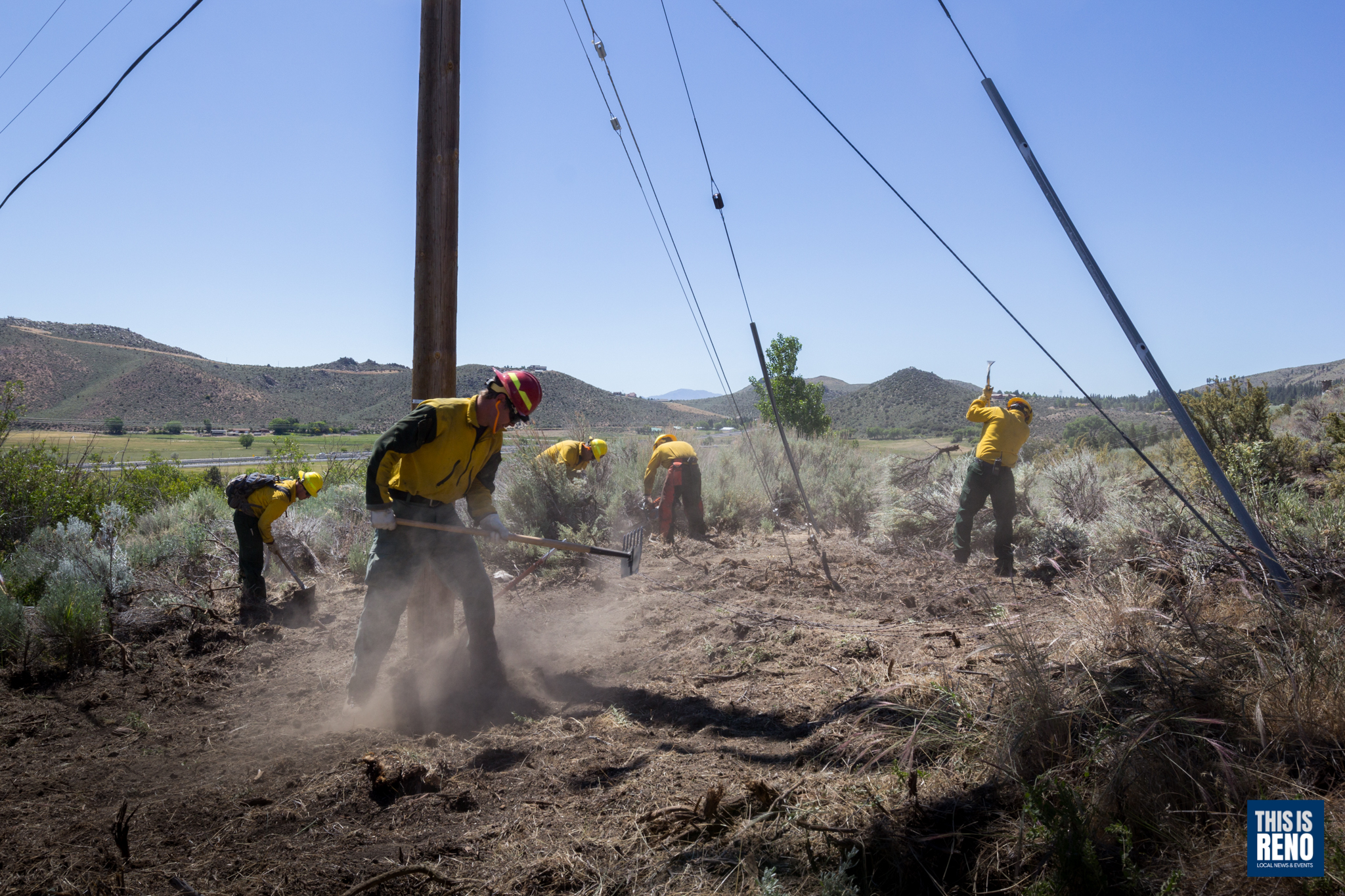The Truckee Meadows Fire Protection District (TMFPD) has launched a new fuels reduction division with a mission to clear targeted areas of ignitable vegetation, also referred to as “fuels,” that present a significant threat of wildfires.
This new wildland fuels reduction division consists of five wildland firefighters, with a goal to expand to at least 20 firefighters within the next two years.
Currently, the crew is working to clear hazardous fuels around the perimeter of power lines in a partnership with NV Energy.
Through this partnership, fire districts throughout the state will begin fuel mitigation efforts funded by NV Energy. This includes fuel reduction around power poles ensuring a minimum clearance of 10 feet, increasing to 30 feet, depending on the type of line.

August Isernhagen is the new Division Chief over the Wildland and Fuels Division within the TMFPD.
“TMFPD has always had a wildland aspect, but in terms of making a wildland and fuels division, this is brand new,” Isernhagen said.
How to set priority on where to begin these mitigation efforts takes planning and a study of past wildfires in the Truckee Meadows.
“Our catastrophic fires, like Washoe Drive and Caughlin Ranch, come from the south and move to the west,” said Isernhagen. “Our first priority was to tie into the Carson City line so we can have an anchor to the south. Carson City will be doing the same [fuel reduction projects] to their line. As we move from Carson to the north we will build a buffer between the wildland and urban interface where those catastrophic fires begin.”
NV Energy & SB 329
Mark Regan is the Fire Chief and Fire Mitigation Specialist for NV Energy. Regan retired after 30 years with the fire service and started with NV Energy last September.
“We are really excited about the partnership,” Regan said. “It is part of the natural disaster program that was required for us to develop through SB 329.”
SB 329 is a Senate Bill that passed during Nevada’s 2019 legislative session. It requires electric utilities to submit a natural disaster protection plan to the Public Utilities Commission of Nevada.
“Part of that process is to cover all disasters in the state of Nevada,” Regan said. “As wildfire is the biggest disaster in the state of Nevada, we developed a plan and sought input from everyone, including the public. We submitted it in February and it is currently under review within the public utility commission.
“One part of that plan is to do fuel mitigation work. NV Energy has been doing fuel mitigation work for 20 years in the form of tree trimming. This next step is removing the vegetation around our right of ways, such as the power line clearing we are working on now.”
NV Energy has developed a priority list in the state based on fire danger.

Tier 3 is extreme fire danger, such as Mt. Charleston and the Tahoe Basin. Tier 2 is the transition within the timber vegetation to the sagebrush area. Tier 1 is flashy fuels such as cheatgrass and sagebrush, mainly found in the valley areas.
“We have developed priorities for this type of work based on our tier system,” Regan said. “We also look at seasonality to switch between tiers such as starting with tier 1 and 2 in the lower elevation areas early in the year while there is still snow covering the tier 3 areas. We are looking at six to seven years to accomplish all the wildland fuels mitigation treatment areas in the state of Nevada.”
Residents can help
As these fuel reduction teams grow in numbers and efficiency, the community also has a role to play in creating a safe environment for when wildfires occur in the Truckee Meadows.
Marc Titus, the Executive Director of the Nevada Network of Fire Adapted Communities under the Nevada Division of Forestry, is working to create “ignition resistant communities.”
One way to accomplish that goal is to create community chapters within the Network. This gives residents access to materials and resources to make changes to their homes and landscapes and have a better chance of withstanding a wildfire.
Titus is new to the area but has been working in fire prevention efforts for many years.
“Here in Nevada, I’m noticing a lot of people are already aware, so the next question becomes, ‘What can I do?’” Titus said. “This is a great program for that next step.”
Creating a neighborhood or community chapter within the network is easy, said Titus. “It provides a community with materials to think about their own home ignition zone and create an ignition resistant community. It includes forming a team of neighbors that are interested in creating a chapter and working together to be ready if or when a wildfire occurs.
“The goal is to create ignition resistant structures, and, when those individual ignition resistant structures are put together, it creates an ignition resistant community. That is what we are aiming to do: create as many ignition resistant communities as we can.”
Creating a chapter has the added benefit of increasing the Truckee Meadows’ chances of success when applying for federal grants as well.
Titus explained, “There are a number of qualifications that help communities to be more successful when grant evaluations occur. One of those qualifications is if they are engaged and involved with the network. That tells the evaluators that the community has a network of resources behind their application.”
More grant opportunities produce more fuel reduction teams and, in conjunction with residents’ preparation, provides the Truckee Meadows the best chance to be prepared when the next wildfire occurs.
Follow the link below to learn more about or join the Network.
LINKS:
NV Division of Forestry: http://forestry.nv.gov/fire-adapted-communities/join-the-network/
Living with Fire: https://www.livingwithfire.com/

